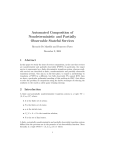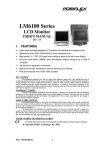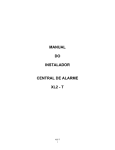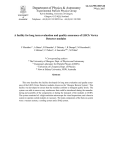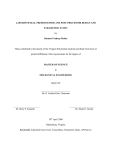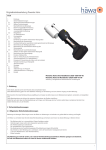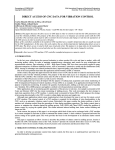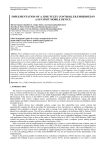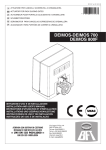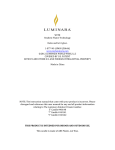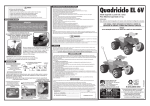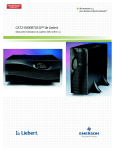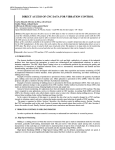Download ethanol utilisation in the ge t-58 turbine applied to electric
Transcript
Proceedings of COBEM 2009 Copyright © 2009 by ABCM 20th International Congress of Mechanical Engineering November 15-20, 2009, Gramado, RS, Brazil ETHANOL UTILISATION IN THE GE T-58 TURBINE APPLIED TO ELECTRIC POWER GENERATION Debaalbeck Borges da Costa Gespi Aeronáutica Ltda – São José dos Campos - SP [email protected] Cristiane A. Martins Instituto Tecnológico de Aeronáutica – São José dos Campos - SP [email protected] Pedro Teixeira Lacava Instituto Tecnológico de Aeronáutica – São José dos Campos - SP [email protected] Abstract. The General Eletric T58 engine is a free-shaft axial flow gas turbine. It was designed to power jet helicopters in the 50s. Since then,it has been used in a number of military helicopter aplications such as the tandem rotor CH-46 Sea Kinght. After more than 50 year sit is clear that there are several T58 out of service. Sometimes, these engines are still in good condition considering land-based operation. Flight safety demands are much more restrit. On other hand, ethanol seems to have an important role considering CO2 emission balance. This work presents the potentiality of ethanol utilisation as fuel in aeronautics turbine engines out of service for the purpose of generating eletric power. Experimental prelimanary tests indicated economic viability and it was also estimated power turbine operation up to 18,000 hours until the first maitanence. . This is one indicative of the high reliability of the aeronautics engines. Whole experimental tests were conducted in the Gespi Aeronautics Ltda and more details will be presented here. Keywords: ethanol, aeronautic turbine, gas turbine, electric plant 1. INTRODUCTION Electric power can be generated in different kinds. In fact, generator has the necessity of something able to cause the shaft and armature to spin. The result is the generation of an electric current. The process responsible for the spin shaft and armature can be so different, as a hydroelectric turbine, wind turbine, a nuclear power plant or the same gas turbine power plant. Independently, all system must be able to turn the copper armature inside the generator and to generate electric current. Particularly, in a gas turbine power plant, fuels are burned to create hot gases which go through a turbine, which spins turning the copper armature inside the generator and generating electric current. Normally, the turbine consists of several stages with each stage consisting of a stationary blade and a rotating blade. Stationary blades convert the potential energy of the exhaust product (temperature and pressure) into kinetic energy (velocity) and direct the flow onto the rotating blades. The rotating blades convert the kinetic energy into forces, caused by pressure drop, resulting in the rotation of the turbine shaft. The turbine shaft is connected to a generator, which produces the electrical energy. The rotation speed is 3000 rpm for 50 Hz systems and 3600 for 60 Hz systems. Development of the turbine applications to flight and to ''light'' (power plants) started at the same time. History registers indicate that the first jet powered aircraft flashed across the skies above the Baltic Sea to start jet Age on August 27, 1939. Hitller´s war launched the jet Age with the gas turbine powered Heinkel He 178. Von Ohain was responsible for that . At the same time, some kilometers from Germany, in 1939 one Swiss company completed the development of the first modern land-based gas turbine. It was installed at Neuchatel in the Swiss Alpine foothills to power a 4-megawatt electrical generator for backup power. (Langston, 2000). Gas-turbine power stations (GTPS) have been recently widespread in power engineering of foreign countries. For example in Russia, it had been widely used. There, electro generators of gas-turbine and electric power station gas turbines were developed by Aviadvigatel on the basis of PS-90А engine. The engine is responsible to provide power to the most modern Russian aircrafts Il-96-300, Тu-204, Тu-214 and even to VIP-aircraft for the President of the Russian Federation. Gas turbine unit models developed until now were GTU-2,5P (2.5 МW), GTU-4P (4 МW) and GTU-6P (6 МW). (Aviadvigatel, 2009). The common fuel is natural gas. Another kind of the gas-turbine power generation is the gas turbine mobile units. These units in general are used as the main electric power source for industrial and domestic Proceedings of COBEM 2009 Copyright © 2009 by ABCM 20th International Congress of Mechanical Engineering November 15-20, 2009, Gramado, RS, Brazil consumers, if there is no trunk power network available or an emergency power supply for peak loads in the presence of trunk mains. Motor Sich PAES-2500, PAES-2500B, EG-2500 are some models manufactured by Motor Sich JSC and can provide 2500 kW nominal. (Sich JSC manual). These units can be fed with natural or casing-head gas, diesel fuel or kerosene. The present work will present preliminary tests with an old aircraft turbine, General Electric T58 model. This is out of service for aeronautics application. This unit was modified to accept ethanol as fuel. The main intention is for electric power application. The idea is to transform this compact aero engine in one ethanol fueled compact gas-turbine for small power stations. 2. 2. EXPERIMENTAL APPARATUS AND INSTRUMENTATION Tests have been conducted on a General Electric T58, free-shaft axial flow gas turbine. The engine is a free turbine engine (no mechanical connection between the gas producer turbine and the power turbine). The power turbine is gas coupled to the gas producer turbine by the combustion gases. The compressor has 10 stages with variable inlet guide vanes and variable stators on the first three stages. The compression ratio is 8.4:1, it flows approximately 13.7 lb/s (11,000 cfm) @ 27,300 rpm. The combustion chamber is of an annular design. Two turbines drive the compressor and one drives the load through the rear at 20,500 rpm. Specific fuel consumption is 0.64 lb/shp/h. The engine weighs 350 lb [159 kg] and produces approximately 1,400 hp (~ 1MW). With a 3.25:1 reduction gearbox this engine can produce 1,270 lb-ft of torque at 6,000 rpm. Table 1 presents part of the Type Certificate No. H20NM. This prescribes conditions and limitations under which T58-GE-100. Table 1 - Engine Limits Sea Level Static - Standard Day Torque (% Q) Power Turbine Speed Gas Generator Speed (% Nf) (% Ng) Power Turbine Inlet Temp. (T5) Takeoff T58-GE-100 (5 Min.) One Engine Inoperative T58-GE-100 (30 Min.) (2-1/2 Min.) Maximum Continuous T58-GE-100 Max. Transient (2 Sec.) Starting Allowable Max. (2 Sec.) Overspeed (15 Sec.) Fuel Aviation Kerosene, JP4 or JP5 103 112 100.0 696° C 123 123 112 112 100.0 102.0 696° C 721° C 86 NA NA 112 NA NA 100.0 NA NA 660° C 840o C 950°C (Note 15) 122 105.0 NA The facility used to perform the experiments here described was designed and constructed at the Gespi Aeronautica Ltda (São José dos Campos, SP) in 2008. The schematic diagram of experimental set up is shown in Fig. 1. After, in Fig. 2 full installation with the torque meter detail. Torque is a twisting force applied to a shaft. A Special torque meter was designed and built to measure the engine power output. Proceedings of COBEM 2009 Copyright © 2009 by ABCM 20th International Congress of Mechanical Engineering November 15-20, 2009, Gramado, RS, Brazil Figure 1 - Schematic arrangement of the engine test stand. 1 - fuel tank; 2 - T58 engine, 3 - Main Gear Box for reduction gearbox; 4- Dynamometer; 5 - throttle valve; 6 - analogy instruments panel; 7 - data acquisition; 8 - server computer coupled to engine and MGB monitors. Figure 2 - Basic setup for turbine measurements. a) torquemeter detail, b) side view Proceedings of COBEM 2009 Copyright © 2009 by ABCM 20th International Congress of Mechanical Engineering November 15-20, 2009, Gramado, RS, Brazil 2.1 INSTRUMENTATION AND TURBINE ENGINE OPERATIONAL CONSIDERATIONS Figure 3 shows the position of the pressure and the temperature sensors around of the engine. Engine was instrumented in order to indicate pressure, temperature, rotation, oil pressure, oil temperature, engine speed, exhaust gas temperature, and fuel flow. At the turbine section there are multiple temperature-sensing instruments, thermocouples that provide temperature readings in and around it. TEMPERATURES: T2 COMPRESSOR INLET TEMPERATURE T3 COMPRESSOR EXIT TEMPERATUTE T5 POWER TURBINE INLET TEMPERATURE T.OIL ENGINE OIL IN TEMP PRESSURE: EOP ENGINE OIL DISCH. PRESS B2 ENGINE OIL SCAV BEARING 2 B3 ENGINE OIL SCAV BEARING 3 B4/5 ENGINE OIL SCAV BEARING 4/5 FCU FUEL DISCH. PRESS FP PUMP FUEL PRESS P3 PRESSURE OUTLET COMPRESSOR ROTATION: NG: GAS GENERATOR SPEED NF: POWER TURBINE SPEED POSITION: STATOR VANE FLOW: FF FUEL FLOW BY OUTLET FCU Figure 3 - Instrumentation position NG indicator NG represents the rotational speed of the low pressure compressor and it is presented on the indicator as a percentage of the design r.p.m. After the start, the speed of the low pressure compressor is governed by the NG turbine wheel. The NG turbine wheel is connected to the low pressure compressor through a concentric shaft. NF indicator NF represents the rotational speed of the high pressure compressor and it is presented on the indicator as a percentage of the design r.p.m. The high pressure compressor is governed by the NF turbine wheel. The NF turbine wheel is connected to the high pressure compressor through a concentric shaft. Additional information can be obtained in the manual (Technical Manual,1985). Proceedings of COBEM 2009 Copyright © 2009 by ABCM 20th International Congress of Mechanical Engineering November 15-20, 2009, Gramado, RS, Brazil The voltage output of all sensors and transducers were adjusted to provide a range output equals 1-5 volts. These signals were monitored through a graphical software developed by National Instruments, the LabVIEW software (LabVIEW, 2003). This is a general-purpose programming system whose programs are built in a block diagram form. LabVIEW program contains extensive library of functions, library for data acquisition, instrument control, measure analysis and report generation applications. A LabVIEW program is also referred as virtual instruments. Virtual instruments are structured as follows: 1. The control or user interface of virtual instruments is known as the front panel. The front panel simulates the panel of a physical instrument. 2. Instructions that are given to the virtual instrument are in the form of a block diagram. 3. Virtual instruments can be used as a "top-level program", or as a subprogram of another program. • Front Panel The "user interface" of VI looks like an instrument (Figure 4). This "user interface" is known as the front panel. • Block Diagram With the block diagram, you can construct a block diagram that wires together objects that send or receive data, perform specific functions, and control the flow of execution. • Icon and Connector An icon is either the pictorial or the textual representation of the purpose of the Virtual Instrument, or its terminals. A connector is a set of terminals that correspond to the sub Virtual Instrument controls and indicators. The user interface of the developed software is shown in Fig. 4. Figure 4 - Front Panel built to T58-GE-100 engine tests 3. METODOLOGY The start-up procedure is almost the same in almost every turbine engines. Exception is when the engine turns via an electric starter rather than bleed air from an APU or a "cross bleed" from the other engine. The starter procedure is very well described by Ashby et al. (2005) included the following: 1. Air turbine is powered up and begins turning the engine. The torque required to accelerate the engine increases with rotor speed as an effect of the increase in the airflow 2. Before reaching the maximum motoring point, fuel is added and the igniter begins to spark. Proceedings of COBEM 2009 Copyright © 2009 by ABCM 20th International Congress of Mechanical Engineering November 15-20, 2009, Gramado, RS, Brazil 3. Once a flame is sustained, the engine begins to accelerate the system (High- Pressure Turbine (HPT) is now doing work) 4. At the self sustaining point, the torque is balanced. At any point prior to the self-sustaining point, disengaging the starter would not allow the engine to achieve idle engine speed. HPT is now extracting enough work to keep the compressor at a constant speed without the help of the starter. The starter does not cutout at this point. 5. More fuel is added, accelerating the engine to idle speed. The starter assists through a portion of this acceleration to reduce the time to idle. In the present work the following procedure was adopted: 1. Ethanol had never ever been utilized as fuel in this start up turbine. Safety procedure demands start up with kerosene fuel. After all ethanol can be used. 2. Start up with kerosene the engine remained in idle regimes within 5 minutes. Engine was accelerated until flight conditions remained in this condition for more 5 minutes. Subsequently, the engine returned to idle condition, which maintained it during 30 minutes. Cycle completed to kerosene fuel. Data acquired. 3. After the engine had worked with kerosene the engine was cut-off. After 15 minutes it was switched off. 4. Then one new starter was made. At this time the fuel utilized was ethanol straight (100%). The engine started up normally and the operation remained stable until the cycle was completed. 5. Data acquired in both cycle were compared through time synchronization. Among some of the things that could be wrong during start are: 1. Too much fuel entrance during start (hot start)., 2. Too little fuel entrance during start (hung start). 3. The start valve fails to close when the starter was released, 4. Oil pressure/Hyd pressure fails to rise, and finally, 5. EGT fails to rise w/i 20 sec. of placing the fuel control lever on. Even with ethanol operation these 5 events, previously described, did not occur. 3. RESULTS AND DISCUSSIONS Early considerations should be presented when the main idea is to find an alternative to apply the ''old'' aero engine turbine. There are some manufactured characteristics not so ideal for power plant application. Aero engines turbines units are lightweight and compact, but it has no large capacities, 30 to 35 MW (in maximums) mainly when compared with heavy-duty machines designed for stationary applications which capacity in large sizes change of 70 to 135 MW. Heavy-duty are suited for combined operations because the turbine exhaust gases are relatively hot (593°C). On the contrary, aero engine turbines are poor candidates for combined cycle applications since the turbine exhaust gases are not especially hot. (Williams and Larson, 1988) A gas turbine unit for power generation or a turbo shaft engine for production of thrust, primarily consists of a compressor, combustion chamber and a turbine. As the air passes through the compressor, experiences an increased in pressure. After that, the air is fed to the combustion chamber leading to one increase in temperature. This high pressure and temperature gas is then passed through the turbine, where it is expanded and the required power is obtained. To operate properly, an engine must be correctly adjusted. Here it is showed some experimental preliminary results of the aero turbine operation with ethanol fuel whose final intention is for power application. Ethanol measurements results will be compared with the same values to common fuel aviation kerosene. It is impractical to cover specific operational procedures and there are certain operational considerations that are common to all turbine engines. They include engine temperature limits, hot start, compressor stall, and flameout. Comparing data tests provided of the kerosene cycle and ethanol cycle 3 parameters pay out attention, T5 - turbine inlet temperature, FF (Fuel Flow) and Stator Vanes. Table 2 shows parameter, range, precision and accuracy of each one. Proceedings of COBEM 2009 Copyright © 2009 by ABCM 20th International Congress of Mechanical Engineering November 15-20, 2009, Gramado, RS, Brazil Table 2 - Parameters characteristics Range Precision Accuracy 100 – 1000 lb/hr ±1% 0,75% power turbine inlet temperature T5 (ºf or ºc) 0 - 1000 ºc ±3°c 1,0% stator vane position (degrees) -5 e 55° ±0,5° 1,0% Nº Parameter 1 fuel flow (lb/hr or kg/s) 2 3 (MINMAX) 1. Turbine engine hot/hung start A hot start is when the EGT exceeds the safe limit. Exhaust gas temperature (EGT) gauge is an engine operating limit used to monitor overall engine operating conditions. Hot starts are caused by too much fuel entering the combustion chamber, or insufficient turbine r.p.m. Any time an engine has a hot start, refer to the AFM, POH, or an appropriate maintenance manual for inspection requirements. If the engine fails to accelerate to the proper speed after ignition or does not accelerate to idle r.p.m., a hung start occurs. A hung start may also be called a false start. A hung start may be caused by an insufficient starting power source or fuel control malfunction. Fuel control in T58-GE-100 is a hydromechanical control with 5 engine operating parameters. These parameters are: (1) Control lever position, (2) Gas generator speed (Ng), (3) Power turbine speed (Nf), (4) Compressor discharge pressure (P3) and (5) Compressor Inlet temperature (T2). This information is furnished by a system of sensors throughout the engine which signal the control servo system. The servos correlate the various signals and translate them into an input to the control which then meters fuel and positions stator vanes. The operation of these 2 variables, the amount of fuel supplied to the combustion chamber and the position of stator vanes produces the desired engine output. Similar behaviour between both fuels can be observed in Figure 5. This is due to loop control. Flow Fuel (FF) was set through FCU (Fuel Control Unit) which always tries to increase flow for ethanol operation. FCU reading lower rotation and is translated with fuel demands. This is an indicative that the fuel system must be calibrated for flow ethanol operation. In fact it must be adjusted for at least one addition of the 10% more fuel. Figure 5 - Fuel Flow - Ethanol and kerosene, time (ms) Proceedings of COBEM 2009 Copyright © 2009 by ABCM 20th International Congress of Mechanical Engineering November 15-20, 2009, Gramado, RS, Brazil 2. Engine temperature limitations The highest temperature in any turbine engine occurs at the turbine inlet. Turbine inlet temperature is therefore usually the limiting factor in turbine engine operation. This is due to the temperature in the combustor where the flame presence is higher, and in many cases much highe then the turbine inlet temperature which is the reference. T5 - turbine inlet temperature Fig. 6 shows the turbine inlet temperature (T5) with ethanol and kerosene operation. It is one of the principal variables in turbine engine. This temperature determines the highest temperature inside the machine. Generally, higher turbine-inlet temperatures increase the net work output of the cycle and improve the cycle efficiency. Measurements show a decrease in temperature with ethanol operation. Leading the maximum turbine inlet temperature to lower value(s) than the unit is rated and because of the thermal stresses reduction at the lower temperatures, the parts lives are anticipated to be longer. Of course, the power output of the unit will be lowered at lower turbine inlet temperatures. However, some applications do not need all the power and someone have spreadsheets that tell them that if they are able to produce slightly less power and to prolong unit operation before shutting down for a maintenance outage, they will actually save money and increase profits in the long run. Turbine Inlet Temperature was a bit lower to ethanol cycle compared to kerosene in about 7%. Although the peak of the starter was lowered, it was still high enough to start it. engine. Figure 6 - T turbine inlet temperature - T58-GE-100 - Ethanol and Kerosene Fuel, Time (ms) 3. Stator Vanes Compressor stalls Although a compressor stall could not be reproduced on the test bench with mistuned settings, a smooth sound indicates that the compressor is in a normal operation. A compressor stall can be described as an imbalance between the two vector quantities, inlet velocity and compressor rotational speed. Compressor stalls occur when the compressor blades’ angle of attack exceeds the critical angle of attack. At this point, smooth airflow is interrupted and turbulence is created with pressure fluctuations. Compressor stalls cause air flowing into the compressor to slow down and stagnate, sometimes reversing direction. Although all gas turbine engines are subjected to compressor stalls, most models have systems that inhibit these stalls. One such system uses variable inlet guide vane (VIGV) and variable stator vanes, which direct the incoming air into the rotor blades at an appropriate angle. The GE T58 turbo-shaft engines incorporate an automated system that varies the inlet blade angle according to the engine load. The Inlet Guide Vane (IGV) system is one of several features that enable these motors 'squeeze out every bit of horsepower' and boast such exceptional power-to-weight ratios. Proceedings of COBEM 2009 Copyright © 2009 by ABCM 20th International Congress of Mechanical Engineering November 15-20, 2009, Gramado, RS, Brazil Variable geometry (VG) of T58-GE-100 engine consists of the variable inlet guides vanes and the first three of stator vanes stages. Figure 7 shows detail about Stator Vane. Even with ethanol operation compressor stall was not observed. But, it is possible to realize that a lower angle is produced by a lower fuel flow. Figure 7: Stator Vanes Angle- T58-GE-100 - Ethanol and Kerosene Fuel, Time (ms) 6. CONCLUSION All gas turbines, whether they are aero engines or land-based industrial units, share the same basic aerothermodynamic cycle and have the same components in the core design. This means interchanged possibility between both. However, there are several tecnological different demands. Aero-engines only operate at full load for a small percentage of time, compared to industrial units which are more commonly expected to operate at continuous full load year after year. Also, in an aero-engine weight has also been a major concern, not just for the engine components themselves, but the amount of fuel. Landbased systems do not have those same weight concerns. This has led to several differences between the design of the two types of engines. The most obvious is that weight - the core engine for a 44 MW LM6000 weighs 7.2 tons compared to 67 tons for a 32 MW. (Robb, 2008). Until now, preliminaries tests indicate that it is possible to obtain safety and steady operation with ethanol fuel in T58-GE-100. Start up occurred without problems and operation is quite good. Temperature Inlet Turbine is lower than kerosene. It is somehow good and at the same time somehow bad. Good because it reduces the stress in material and bad once that yield lower torque as well. Further and detailed tests are still necessary in order to conclude this work. 8. REFERENCES Ashby M., Simpson J., Singh A., Ferguson E. and Frontera M., Intelligent Engine Systems, Work Element 1.3: Sub System Health Management, National Aeronautics and Space Administration, Glenn Research Center, NASA/CR— 2005-213965, October 2005 Aviadvigatel, http://www.pmz.ru/eng/products/gtu-for-stations/ Proceedings of COBEM 2009 Copyright © 2009 by ABCM 20th International Congress of Mechanical Engineering November 15-20, 2009, Gramado, RS, Brazil LabVIEW 2003, LabVIEW 7 Express, User Manual, National Instruments, April 2003 Langston L. S., Flight and Light, Mechanical Engineering Power, May, 2000. Robb, D., Aero Vs Industrial, Turbomachinery International. FindArticles.com. http://findarticles.com/p/articles/mi_qa5385/is_200801/ai_n25138845/ , Jan/Feb, 2008. 13 Aug, 2009. Technical Manual, Turboshaft Engine, Model T58-GE-5, T58-GE-100, 1 April 1985. Williams R. H. and Larson E. D., Aero Derivative Turbines for Stationary Power, Ann. Rev. Energy, 13:429--89, 1988. 9. RESPONSIBILITY NOTICE The authors are the only responsible for the printed material included in this paper.











